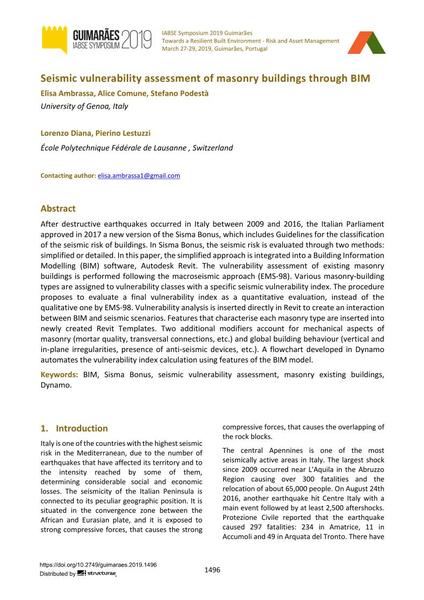Seismic vulnerability assessment of masonry buildings through BIM

|
|
|||||||||||
Bibliographic Details
| Author(s): |
Elisa Ambrassa
(University of Genoa, Italy)
Alice Comune (University of Genoa, Italy) Stefano Podestà (University of Genoa, Italy) Lorenzo Diana (École Polytechnique Fédérale de Lausanne , Switzerland) Pierino Lestuzzi (École Polytechnique Fédérale de Lausanne , Switzerland) |
||||
|---|---|---|---|---|---|
| Medium: | conference paper | ||||
| Language(s): | English | ||||
| Conference: | IABSE Symposium: Towards a Resilient Built Environment Risk and Asset Management, Guimarães, Portugal, 27-29 March 2019 | ||||
| Published in: | IABSE Symposium Guimarães 2019 | ||||
|
|||||
| Page(s): | 1496-1503 | ||||
| Total no. of pages: | 8 | ||||
| DOI: | 10.2749/guimaraes.2019.1496 | ||||
| Abstract: |
After destructive earthquakes occurred in Italy between 2009 and 2016, the Italian Parliament approved in 2017 a new version of the Sisma Bonus, which includes Guidelines for the classification of the seismic risk of buildings. In Sisma Bonus, the seismic risk is evaluated through two methods: simplified or detailed. In this paper, the simplified approach is integrated into a Building Information Modelling (BIM) software, Autodesk Revit. The vulnerability assessment of existing masonry buildings is performed following the macroseismic approach (EMS-98). Various masonry-building types are assigned to vulnerability classes with a specific seismic vulnerability index. The procedure proposes to evaluate a final vulnerability index as a quantitative evaluation, instead of the qualitative one by EMS-98. Vulnerability analysis is inserted directly in Revit to create an interaction between BIM and seismic scenarios. Features that characterise each masonry type are inserted into newly created Revit Templates. Two additional modifiers account for mechanical aspects of masonry (mortar quality, transversal connections, etc.) and global building behaviour (vertical and in-plane irregularities, presence of anti-seismic devices, etc.). A flowchart developed in Dynamo automates the vulnerability index calculation using features of the BIM model. |
||||
| Keywords: |
BIM Dynamo Sisma Bonus seismic vulnerability assessment masonry existing buildings
|
||||
